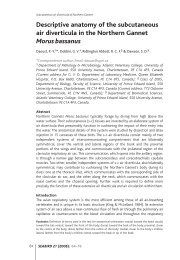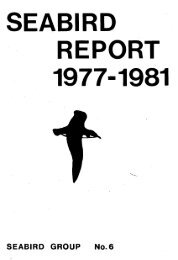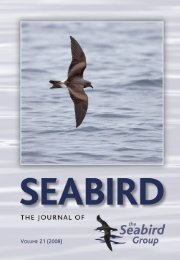You also want an ePaper? Increase the reach of your titles
YUMPU automatically turns print PDFs into web optimized ePapers that Google loves.
156 B. CADIOU Atlantic <strong>Seabird</strong>s 3(4)<br />
Table 1. Breeding parameters for European Storm-petrel in Brittany (data from Enez<br />
Kreiz islet, Molène archipelago). Sample size in brackets.<br />
Tabel 1. Broedsucces van Stormvogeltjes in Bretagne (gegevens verzameld op Enez<br />
Kreiz eiland, Molène eilandengroep). Steekproefgrootte tussen haakjes.<br />
Hatching Fledging Breeding<br />
Year Sites a success (%) b success b, c success d<br />
1997 all 76.1-95.7 (46) ? ?<br />
1998 all 63.6-80.0 (55) ? ?<br />
1999 all 67.0-78.7 (94) 0.68-0.79 (74, 63) 0.53 (94)<br />
old 69.5-81.4 (59) 0.71-0.83 (48, 41) 0.58 (59)<br />
‘new-old’ 60.0-66.7 (15) 0.60-0.67 (10, 9) 0.40 (15)<br />
new 65.0-80.0 (20) 0.63-0.77 (16, 13) 0.50 (20)<br />
a category of sites: old = sites with proof of occupancy at least in 1998 and 1999, ‘new-old’ =<br />
previously known sites but not occupied in 1998, new = sites unknown before 1999;<br />
b uncertainty for hatching and fledging success was due to some sites where breeding failure<br />
occurred either at the egg stage or at the chick stage (see Methods for the calculation of<br />
minimum and maximum values); c for hatched eggs only; d overall breeding success (young<br />
fledged per egg laid); ? = no precise data<br />
indicating that breeding failure mainly occurred in the second part of the<br />
incubation period.<br />
<strong>The</strong>re was no between-year difference of hatching success for the<br />
minimum estimates (χ 2 2 = 1.56, n.s.) but the difference was significant for the<br />
maximum estimates (χ 2 2 = 6.81, P < 0.05), with a decrease from 1997 to 1998-<br />
1999 (Table 1). Precise data on fledging and breeding success were available<br />
only in 1999. Fledging success ranged between 0.68 and 0.79 for hatched eggs,<br />
and overall breeding success was 0.53 young fledged per egg laid (Table 1). Of<br />
the 13 nests where breeding failure occurred at the chick stage, the corpses were<br />
found in five cases (chick’s age less than 1 week in four cases and less than 4<br />
weeks in one case). In the eight remaining cases the chick disappeared between<br />
two subsequent visits; chick’s age less than 3 weeks in one case, less than 4<br />
weeks in six cases, and less than 6 weeks in one case. <strong>The</strong> value obtained for<br />
breeding success included an unknown number of older chicks depredated by<br />
Great Black-backed Gulls Larus marinus, before fledging when they left their<br />
burrows at night to exercise their wings or during the night of departure. At least<br />
two chicks were preyed upon on Enez Kreiz in 1999. <strong>The</strong> first one was 40-60<br />
days old (feather remains were found nearby the entrance of the burrow), and<br />
the second one was 50-70 days old (the ring was found in a regurgitated gull<br />
pellet on the islet; the nest of this chick, found late, was not included in the<br />
study sample). <strong>The</strong> first chicks generally fledged around mid August, whereas








